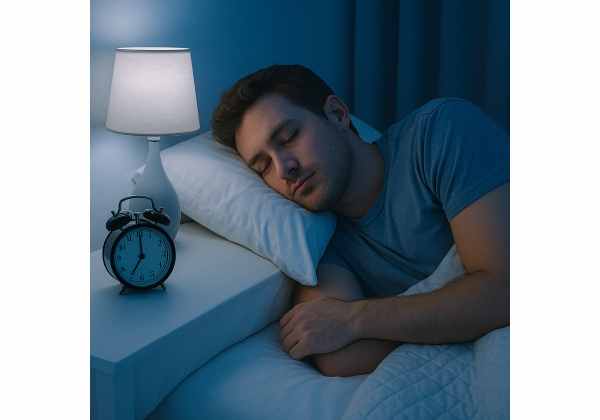
Poor sleep and hard evenings can tilt your appetite in the wrong direction. When you cut sleep short or shift your schedule, hunger hormones change: ghrelin nudges you to eat, leptin keeps you satisfied, and both respond to sleep, light, stress, and meal timing. The good news: you can influence these signals with practical daily habits—morning light, earlier protein, steadier meals, and a calmer wind-down. This guide explains how the system works and gives you a clear plan you can start today. If you want a broader foundation for sustainable progress—habits, sleep, and stress skills that support weight change—begin with our concise habits-first framework, then use the steps below to align hormones with your goals.
Table of Contents
- Hunger hormones and sleep
- How short sleep changes appetite
- Rebalance hunger today
- Meal timing and protein
- Evening routine and light
- Stress, cortisol and cravings
- Troubleshooting and safety
- Frequently Asked Questions
Hunger hormones and sleep
Ghrelin and leptin, in plain language
- Ghrelin is produced mainly in the stomach. It rises before meals, makes food look and smell more appealing, and drops after you eat. Think “go get food.”
- Leptin is produced by fat cells. It helps your brain sense stored energy and meals you have eaten. Higher leptin signals, “We are okay—slow down.”
Other players that matter
- GLP-1 and PYY (from the gut) increase after protein- and fiber-rich meals and reinforce fullness.
- Insulin helps move glucose into cells; poor sleep can worsen insulin sensitivity, which often increases cravings.
- Cortisol (the stress hormone) interacts with appetite and sleep timing; a late, bright, and stressful evening can raise it when you want it low.
Where sleep fits
Sleep regulates the timing and amplitude of these signals. Short, fragmented, or mistimed sleep tends to increase ghrelin, dampen leptin, and tilt choices toward high-calorie foods. Aligning sleep with your natural rhythm reverses much of that drift.
What “alignment” means
- A stable wake time anchors your clock.
- Morning light and movement tell the brain daytime has begun.
- Dimmer evening light and a steady wind-down raise sleep pressure and mute late-night cravings.
What to do first
- Aim for a steady sleep window most nights.
- Front-load the day with 25–35 g protein at breakfast and 2 cups of produce by lunch to support GLP-1 and PYY.
- Keep one simple evening ritual (tea, teeth, lights down) to compress the late-night snacking window.
If you are new to healthy weight change, skim the essentials in our safe weight loss basics so the tactics below sit on solid ground. Then use the next sections to fine-tune appetite signals without obsessing over numbers.
How short sleep changes appetite
Sleep loss acts on appetite in several predictable ways. Understanding them helps you design simple counters.
1) Ghrelin goes up, leptin goes down
After a short night, people often feel hungrier despite eating normally the day before. That is not just in your head: higher ghrelin and lower leptin prime you to eat more and choose faster energy.
2) Food reward increases
The brain’s reward circuits light up more in response to sweets and high-fat foods when you are underslept. Translation: the donut feels more persuasive, and it is harder to say no.
3) Timing drift expands the eating window
Late nights add hours when snacking can happen, especially in bright rooms. Even if daily calories stay similar, shifting more intake late can worsen reflux, sleep quality, and next-day hunger.
4) Insulin sensitivity drops short-term
After a poor night, your body handles carbohydrates less efficiently. People tend to crave more and feel less satisfied by the same meals.
Practical counters that work
- Go to light early: Get 5–15 minutes of outdoor light within an hour of waking. Morning light anchors your clock and makes earlier sleep easier.
- Protein early, fiber often: Start with 25–35 g protein at breakfast and include fiber (oats, fruit, beans, vegetables) at each meal to support GLP-1 and PYY.
- Shrink the late window: Keep a consistent wind-down and dim lights after dinner. If you are hungry later, choose a planned protein + fiber snack, not snack-grazing.
If sleep itself needs work—duration, timing, or quality—review our overview of healthy sleep targets to decide whether to adjust bedtime, wake time, or both. Improvements in sleep often reduce cravings within a week.
Rebalance hunger today
Here is a one-day plan to nudge hormones toward steadier appetite. It is practical, not perfect.
Morning (0–2 hours after waking)
- Light + movement: Step outside for light; add a brief walk or easy mobility.
- Protein-forward breakfast (25–35 g): Examples—eggs with fruit; Greek yogurt with oats and berries; tofu scramble with vegetables.
- Hydration: Drink 300–500 ml of water or unsweetened tea.
Midday
- Balanced lunch: ½ plate vegetables, ¼ lean protein, ¼ smart starch (whole grains or potatoes) with a thumb of added fat.
- Short walk: 5–10 minutes after lunch supports glucose control and afternoon energy.
Afternoon
- Caffeine cut-off: Stop caffeine 6–8 hours before bed to protect sleep pressure.
- Planned snack (if needed): Choose protein + fiber (cottage cheese and tomatoes, tuna on rice cakes, apple with 1 tbsp peanut butter).
Evening
- Protein at dinner (25–35 g) + vegetables: This steadies ghrelin and supports next-morning leptin.
- 10-minute walk after dinner or easy stair laps.
- Wind-down sequence: Tea, teeth, lights down; reserve screens for earlier hours or use night mode.
If you wake hungry at night
- Check your day: was dinner protein low or too early? Add a small protein + fiber snack 60–90 minutes before bed tomorrow and move dinner 30 minutes later.
For a simple morning anchor that sets the rest of the day up, copy the easy steps in our short morning routine—light, water, and a protein start.
Meal timing and protein
Why timing matters
Your gut hormones follow a rough schedule. Long gaps with low protein drive ghrelin up; regular meals with adequate protein and fiber raise GLP-1 and PYY and steady leptin signals. You do not need perfect intervals—just fewer extremes.
A workable template
- Three main meals spaced 3–5 hours apart.
- Protein target per meal: 25–35 g (palm-sized lean meat, ¾–1 cup cottage cheese, Greek yogurt, tofu or tempeh, or a combo of beans and grains).
- Fiber target: Build toward 25–38 g/day from fruit, vegetables, beans, and whole grains.
- Fats for satisfaction: Include a thumb-size portion of olive oil, nuts, seeds, or avocado most meals.
Use “front-load + cap” on hunger days
- Front-load: Bigger breakfast or lunch (protein + fiber) on days you expect strong cravings.
- Cap: A planned protein + fiber snack after dinner if you truly feel hungry—then close the kitchen with tea and brushing.
Post-meal movement
Walk 10 minutes after meals when you can. Apart from metabolic benefits, it interrupts grazing and reinforces the end of eating.
When schedules are irregular
If work or family life makes timing hard, anchor to events (after school drop-off, end of shift, commute home) rather than clock time. Keep shelf-stable protein and fruit nearby to avoid long gaps.
For a deeper look at spacing and examples, see our guide to practical meal timing for appetite control.
Evening routine and light
Light is a powerful appetite tool. Bright, blue-weighted light at night suppresses melatonin and keeps you awake, which lengthens the snacking window and increases late cravings. You do not need a dark cave—just deliberate steps that tilt the evening toward sleep.
Three lighting moves that matter
- Dim after dinner: Switch overheads to lamps; lower screen brightness or use night mode.
- Create zones: Keep the kitchen brighter during cooking but dim it during cleanup; bright rooms invite grazing.
- Bedroom routine: Dark, cool, and quiet. Consider an eye mask if full blackout is impractical.
Wind-down that calms appetite
- Tea and teeth: Brew herbal tea, then brush to add a mint boundary.
- Hands-busy, mind-light: Stretching, a short puzzle, or a warm shower. Idle scrolling often re-stokes desire to snack.
- Set tomorrow’s start: Lay out breakfast items (oats, yogurt, fruit) to reduce morning friction.
Screens and timing
If evenings include screens, schedule the most stimulating content earlier. Use night mode and keep at least 30–60 minutes of low-light, non-screen time before bed.
For more on light hygiene and phone settings that help, scan our targeted guide to blue light and sleep and copy the two tweaks that fit your devices.
Stress, cortisol and cravings
Stress changes appetite—sometimes down, often up. Cortisol interacts with ghrelin, leptin, and reward pathways; chronic stress shifts preferences toward energy-dense foods and makes late eating more likely.
Fast regulation you can use daily
- Breath pacing: 4 seconds in, 6 out for two minutes before dinner or when the urge to snack hits. Longer exhales cue the body to downshift.
- Tension release: 60–120 seconds of easy mobility (neck rolls, shoulder circles, cat-cow) during evening transitions.
- Brief sunlight + walk: A 5–10 minute outdoor loop after work is a powerful mood reset.
Boundaries that lower stress-eating
- Kitchen close: Tea, teeth, lights down—same order every night. Rituals reduce decision fatigue.
- Snack scripts: “If I am hungry, I will choose protein + fiber. If I still want dessert, I will plate a small portion and sit to eat it slowly.”
- Work shut-off: A micro-routine for ending work (close tabs, write tomorrow’s first task, put laptop away) prevents stress-eating while half-working.
For more tools that reduce stress-driven cravings, pull a couple of quick tactics from our focused playbook on stress and overeating—then practice them at the same time each evening.
Troubleshooting and safety
If appetite feels “out of nowhere”
- Check the basics: protein at breakfast and dinner, fiber each meal, caffeine cut-off, morning light, evening dimming.
- Audit your gaps: Do you go 6+ hours without eating? Long gaps spike ghrelin and drive night cravings.
- Look at sleep timing: A drifting bedtime expands the snacking window and disrupts leptin signaling.
If mornings start with no appetite and nights end in grazing
- Shift 200–300 kcal from evening to breakfast for a week—usually protein + fruit or oats.
- Move dinner 30–60 minutes earlier and add a short post-meal walk.
- Keep dessert planned and portioned, then close the kitchen.
If you wake to eat
- Evaluate sleep quality: reflux, pain, bathroom trips, or stress may be waking you.
- Consider a small, planned protein + fiber snack 60–90 minutes before bed while you adjust dinner timing.
Medical considerations
- Sleep apnea and other sleep disorders can severely disrupt appetite hormones. If you snore loudly, feel unrefreshed, or have witnessed pauses in breathing, seek evaluation.
- Medications (e.g., certain antidepressants, steroids) affect hunger and weight. Do not change prescriptions without medical guidance.
- If you have diabetes or are on glucose-lowering medications, coordinate meal timing changes with your clinician.
Mindset reminders
- Target 5 steady days out of 7; consistency shapes hormones far more than perfection.
- When you lapse, your reset is simple: water on waking, protein-forward breakfast, short walk, evening lights down.
Your appetite system is adjustable. Small, repeatable changes—timing, light, protein, fiber, stress relief—recalibrate signals so it is easier to eat in line with your goals.
Frequently Asked Questions
How many hours of sleep steady hunger best?
Most adults do well with 7–9 hours in a consistent window. Stable wake times matter most. When sleep falls short, ghrelin rises and leptin falls, which increases cravings. Improve one variable at a time—wake time, light, or wind-down—rather than attempting a full overhaul overnight.
What should I eat at breakfast to control appetite?
Aim for 25–35 g protein plus fiber and fluid: eggs and fruit, Greek yogurt with oats and berries, or tofu scramble with vegetables. Protein supports fullness hormones (GLP-1, PYY), and fiber adds volume that lasts into late morning.
Do late-night snacks always hurt sleep?
Not always. If you are genuinely hungry, a small protein + fiber snack 60–90 minutes before bed can help. Ultra-rich, spicy, or very large portions near bedtime can disturb sleep and worsen reflux. Keep night snacks planned and modest.
Can a 10-minute walk really affect appetite?
Yes. Short walks after meals aid digestion, smooth post-meal glucose, and reduce grazing. They also mark a clean end to eating, which helps with routine. If weather is poor, walk indoor hallways or take the stairs for a few easy laps.
How long until changes in sleep and meals affect cravings?
Many people notice steadier appetite within 3–7 days of consistent sleep timing, morning light, and protein-forward meals. Cravings may still appear, but they feel less urgent. Keep your routine simple and repeatable to lock in the effect.
What if stress is the main driver of my hunger?
Use a two-step plan: reduce activation (breath pacing, light stretching, a brief walk) and add structure (tea, teeth, lights down). Keep one or two go-to comfort options that are not food. If stress remains high, address workload, boundaries, and sleep first.
References
- Associations of short sleep duration with appetite-regulating hormones and adipokines: A systematic review and meta-analysis — 2020 (Systematic Review & Meta-analysis)
- Effects of sleep manipulation on markers of insulin sensitivity: A systematic review and meta-analysis of randomized controlled trials — 2022 (Systematic Review & Meta-analysis)
- Recommendations for daytime, evening, and nighttime indoor light exposure to best support physiology, sleep, and wakefulness in healthy adults — 2022 (Guideline)
- Efficacy of Postprandial Exercise in Mitigating Glycemic Responses in Overweight Individuals and Individuals with Obesity and Type 2 Diabetes-A Systematic Review and Meta-Analysis — 2023 (Systematic Review & Meta-analysis)
- Impacts of dietary animal and plant protein on weight and glycemic control in health, obesity and type 2 diabetes: friend or foe? — 2024 (Review)
Disclaimer
This guide provides general information on sleep, appetite, and nutrition for healthy adults. It is not medical advice. If you have medical conditions, take prescription medications, are pregnant, or suspect a sleep disorder (such as sleep apnea), speak with a qualified healthcare professional before changing your sleep or diet.
Share and follow
If this article helped you understand hunger hormones and sleep, consider sharing it with someone who might benefit. You are welcome to follow us on Facebook, X, or any network you prefer for calm, practical updates on habits, sleep, stress, and nutrition.










